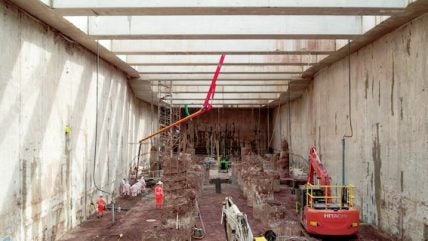
The portal at Washwood Heath is now ready for the two TBMs building the twin-bore tunnel to complete their journeys from Water Orton in North Warwickshire.
The earthworks operation has taken a team of 130 people from HS2’s construction partner Balfour Beatty Vinci (BBV) nine months to complete.
The Washwood Heath portal is the deepest of four tunnel portals on the Midlands section of the HS2 route. A two-year programme of ground reinforcement works, delivered by the Bachy Soletanche and Balfour Beatty Ground Engineering joint venture (SB3), began in November 2021 to prepare for the portal’s excavation.
The portal is at the start of a 750m-long cut and cover structure, which is currently being excavated and built by SB3. This is where HS2 trains will emerge from the tunnel and travel below ground level, before rising onto a series of viaducts into Birmingham’s Curzon Street Station.
Mary Ann, the first TBM to launch from Water Orton in 2023, is expected to break through the portal wall at Washwood Heath by the end of this year. TBM Elizabeth is set to finish her drive by autumn next year.
Groundwork specialists from Coventry-based Duo Group supported BBV with the complex excavation programme to extract 53,400m3 of earth. The spoil has been transported on specially built haul roads to support construction of the Delta Junction – a triangular section of 13 viaducts in North Warwickshire.
At 65ha, Washwood Heath is one of HS2’s largest construction sites. Next to the tunnel portal, HS2’s Depot and Network Integrated Control Centre will also be built, providing the nerve centre for the high-speed rail network. Here, trains will be serviced and stored and the real-time operation of the railway will be controlled.
Balfour Beatty Vinci project manager Tim Cook said completing the 22m-deep Bromford Tunnel portal was a significant moment for the project.
“The team is now focused on the next challenge on this vast site – a 750m-long cut and cover structure next to the portal, where HS2 trains will emerge from the tunnel and travel below ground level, before heading into Birmingham,” he said.
On the wider 65ha site, more than one million m3 of earth has been excavated and reused to level the ground, paving the way for detailed design and construction of the new maintenance depot and control centre to start next year.
By recycling and reusing material on the site, BBV has eliminated the need to import aggregate, a strategy which has avoided over 50,000 lorry movements on local roads.
BBV has also diverted Wash Brook, which ran south through the site. The brook, which connects to the River Tame, is one of the environmental design features planned for the site.







